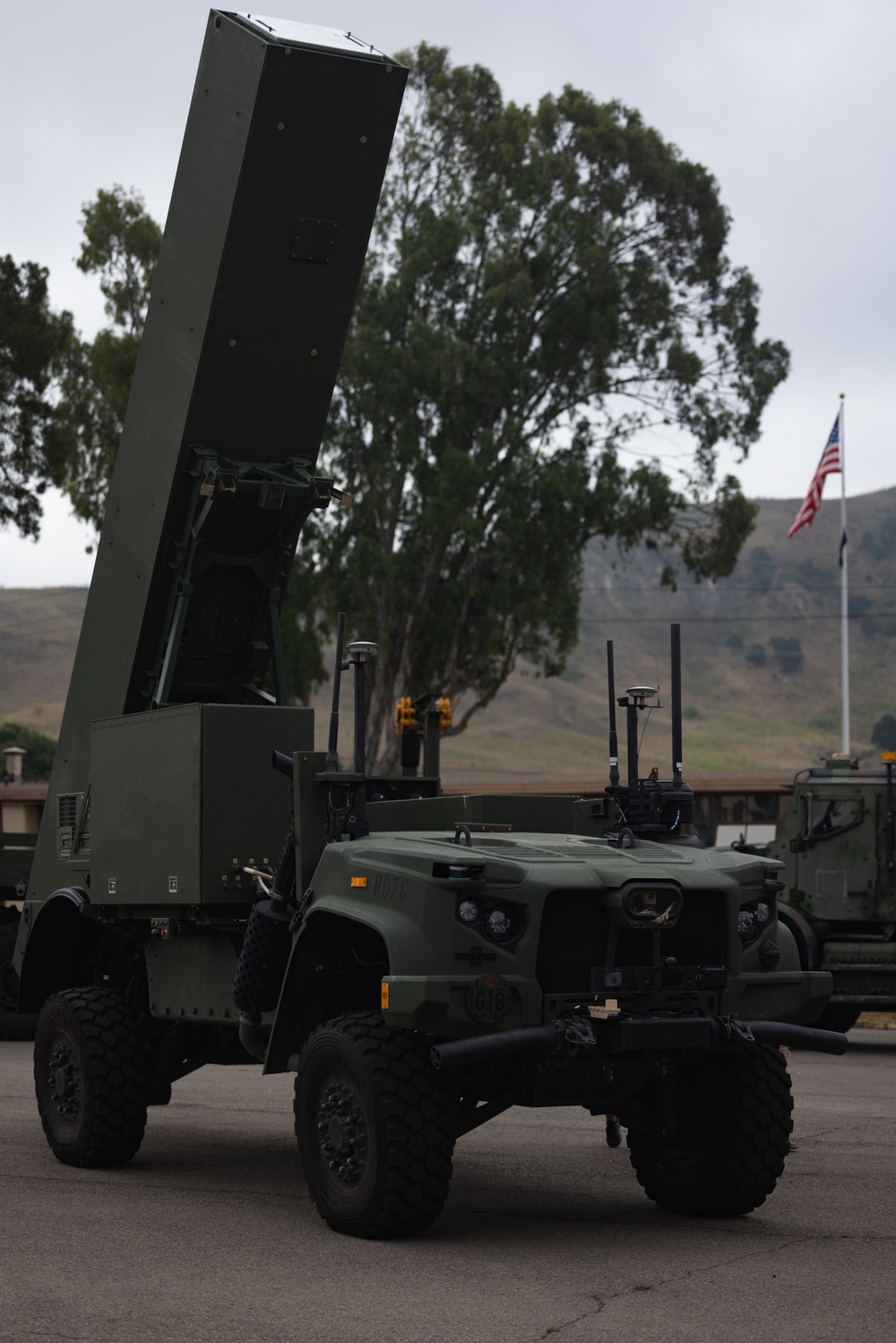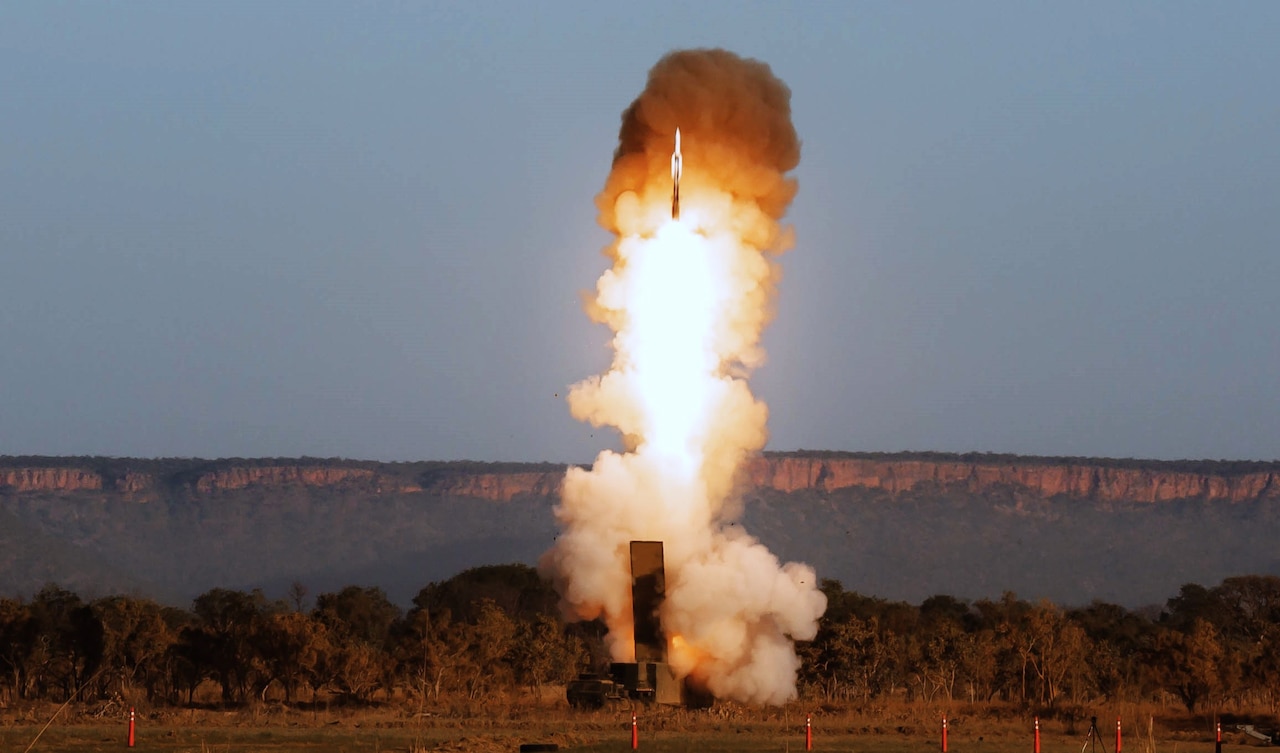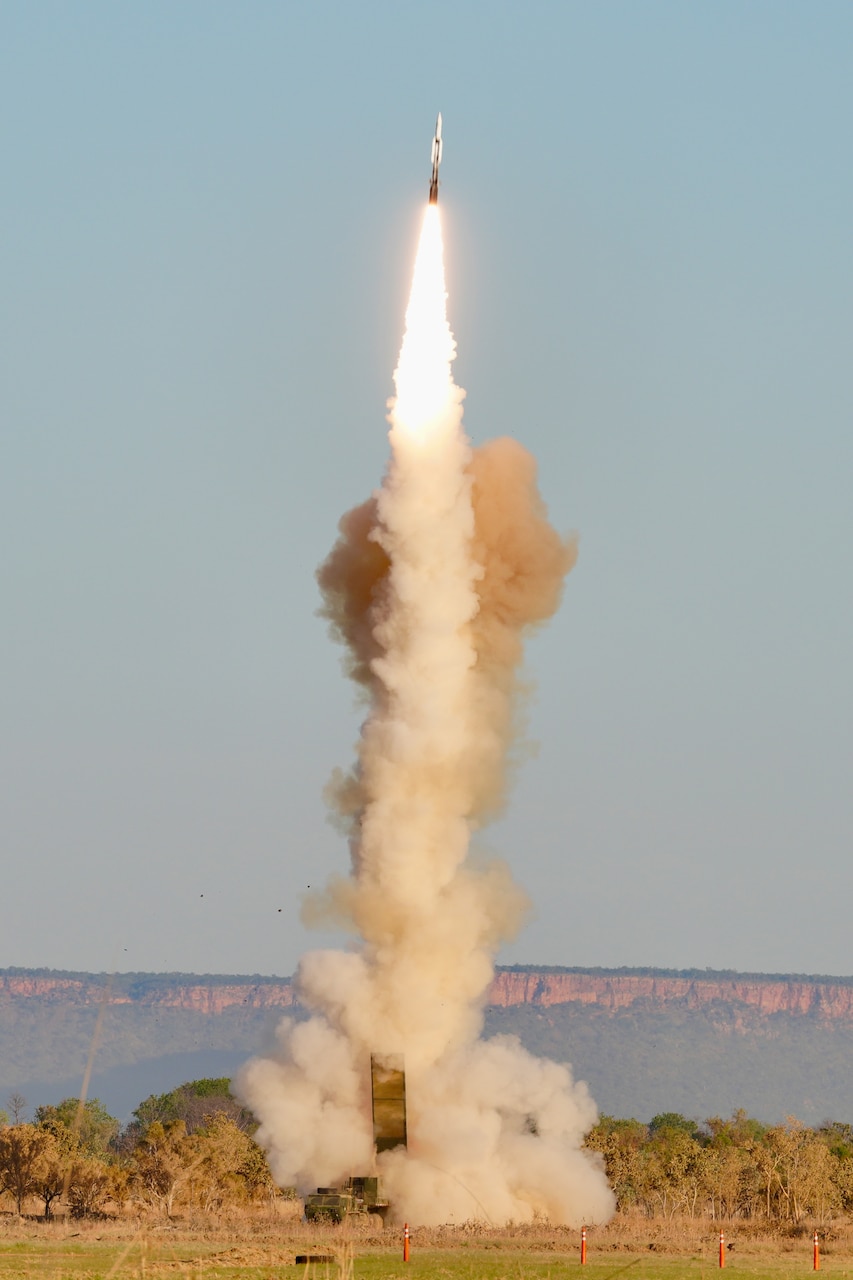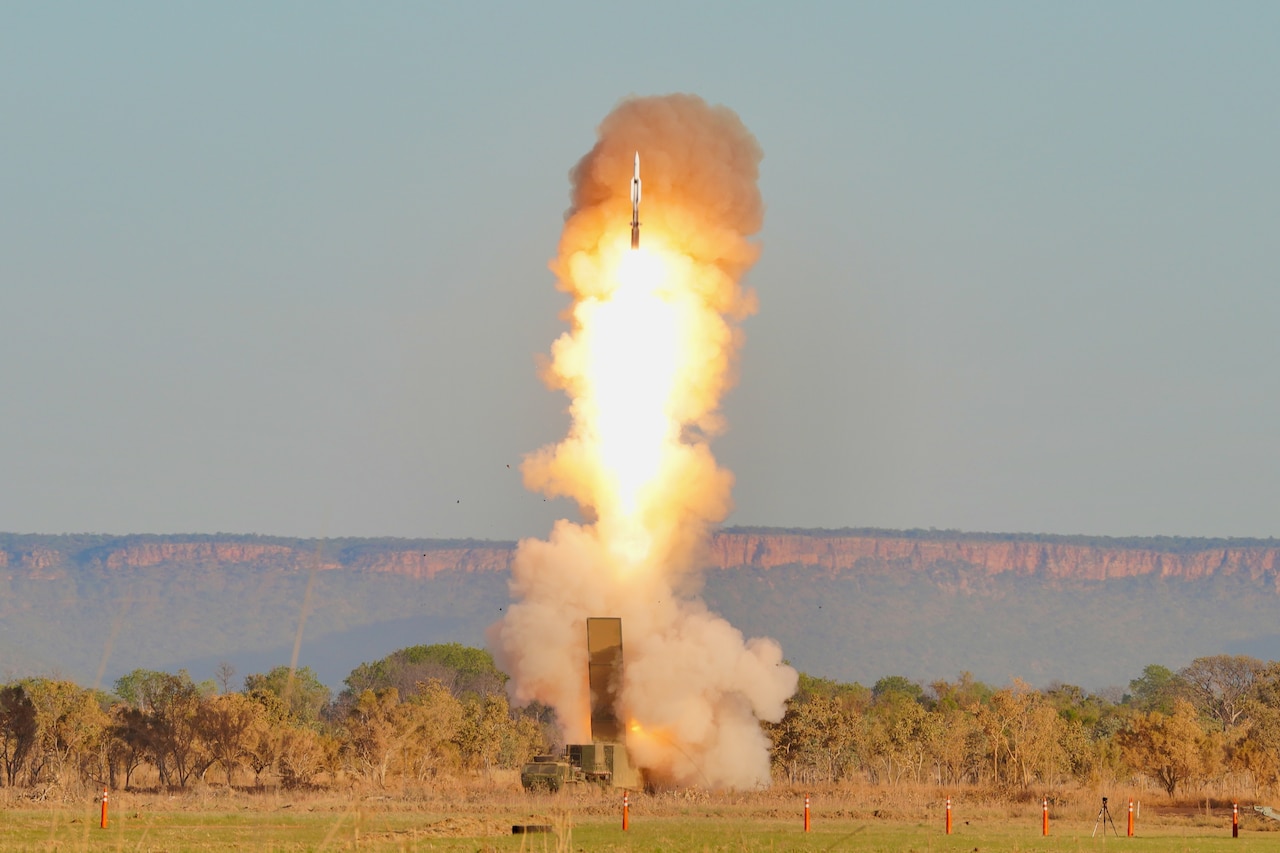Seite 13 von 13
Re: USA: "Low-yield nuclear weapon" & "INF Range Ground-launched Missile System"
Verfasst: Mi 16. Apr 2025, 22:35
von theoderich
USMC’s Tomahawk Cruise Missile Launching Drone Truck Eyed By Army
https://www.twz.com/land/usmcs-tomahawk ... ed-by-army
 https://www.lockheedmartin.com/en-us/pr ... tions.html
https://www.lockheedmartin.com/en-us/pr ... tions.html
theoderich hat geschrieben: ↑Mi 26. Jul 2023, 19:22
A U.S. Marine Corps Long Range Fires Launcher is staged for the activation ceremony for Long Range Missile Battery A, 11th Marine Regiment, 1st Marine Division, at Marine Corps Base Camp Pendleton, California, July 21, 2023.
https://www.dvidshub.net/image/7931712/ ... le-battery
Army awards Precision Strike Missile early operational capability contract (3. April 2025)

U.S. Army Contracting Command-Redstone Arsenal awarded an indefinite-delivery, indefinite-quantity contract, with a ceiling value of $4.9 billion, to Lockheed Martin Missiles and Fire Control on March 28, 2025. The first delivery order on the IDIQ contract procures 400 Precision Strike Missile Increment 1 missiles.
https://www.army.mil/article/284406/arm ... y_contract
Re: USA: "Low-yield nuclear weapon" & "INF Range Ground-launched Missile System"
Verfasst: Mo 5. Mai 2025, 23:41
von theoderich
theoderich hat geschrieben: ↑Sa 22. Mär 2025, 15:47US Army Conducts Successful Precision Strike Missile Long-Range Flight Test

Re: USA: "Low-yield nuclear weapon" & "INF Range Ground-launched Missile System"
Verfasst: Mi 11. Jun 2025, 14:05
von theoderich
Weapon Systems Annual Assessment:
DOD Leaders Should Ensure That Newer Programs Are Structured for Speed and Innovation
https://www.gao.gov/products/gao-25-107569
Program Performance
Since our last assessment, the MRC program completed new equipment training and accepted delivery of battery 2 in September 2024. According to the program office, production of battery 3 and battery 4 is scheduled to be completed in 2025 and 2026, respectively.
The program plans to conduct an operational demonstration in 2026 with flight test events for the Standard Missile-6 Block IA and Tomahawk Block V missiles. This testing will support the fielding of battery 4 and provide the program with a better understanding of the system’s capabilities and limitations. According to the program, each test event will use tactically representative hardware, and soldiers will operate the equipment.
In April 2024, the Army successfully deployed the MRC system for the first time. Battery 1—developed by the Army’s RCCTO
prior to the current MTA effort—was sent to the Philippines as part of a bilateral exercise in support of U.S. Indo-Pacific Command and U.S. Army Pacific. The program office expects to complete the lessons learned process for this exercise in the second quarter of fiscal year 2025.
https://www.gao.gov/assets/gao-25-107569.pdf
Army Modernization:
Leading Practices Could Better Support Delivery of Artillery and Missiles
https://www.gao.gov/products/gao-25-107263
Precision Strike Missile (PrSM). The Army intends to develop and produce PrSM in a series of four increments that increase the capability of the missile over time. The Army initiated efforts using two acquisition pathways to develop and produce PrSM Increment 1 missiles. The Army first initiated the PrSM Increment 1 program under the Program Executive Office for Missiles and Space in March 2017 on what is now referred to as the MCA pathway. In August 2021, the office initiated a second effort on the urgent capability acquisition pathway.
[...]
While the program plans to continue developing, testing, and producing Increment 1 missiles, it is also focused on development of future increments. The PrSM program has begun technology development for Increment 2, which will upgrade the missile with a seeker to hit moving targets. The Army also plans for Increments 3 and 4, which will upgrade the payload and range of the missile, respectively. PrSM program officials noted that the Army has yet to schedule when it plans to initiate acquisition of Increments 3 and 4.
Mid-Range Capability (MRC). RCCTO initiated MRC in November 2020 under its accelerated prototyping authority. Under this authority, RCCTO successfully conducted the first flight test and accepted delivery of the first MRC prototype battery and 16 missiles. According to officials, RCCTO fielded the first battery in the U.S. and then deployed it in the Philippines to further test the system and obtain end-user feedback. It then transitioned the effort to the Program Executive Office for Missiles and Space, which had initiated an MTA for rapid prototyping in November 2023.
The Program Executive Office for Missiles and Space expects to upgrade the capabilities of MRC. The office took delivery of the second battery in September 2024 and is planning to produce two additional batteries by 2026 under the MTA for rapid prototyping pathway. The upgraded capabilities include enhanced communications, increased survivability, and integration of future Standard Missile-6 and Tomahawk cruise missile variants. The office also plans to initiate an MTA for rapid fielding pathway in the future to produce a fifth MRC battery but has yet to do so.
https://www.gao.gov/assets/gao-25-107263.pdf
 https://www.dvidshub.net/image/9096882/ ... off-weapon
https://www.dvidshub.net/image/9096882/ ... off-weapon
Re: USA: "Low-yield nuclear weapon" & "INF Range Ground-launched Missile System"
Verfasst: Di 8. Jul 2025, 02:58
von theoderich
theoderich hat geschrieben: ↑Mi 26. Jul 2023, 19:22
11th Marine Regiment activates first long-range missile battery (25. Juli 2023)
Marines Axe Adoption Of Ground-Launched Tomahawk Cruise Missile
https://www.twz.com/land/marines-axe-ad ... se-missile
Hier eine mögliche Begründung:
A series of wargames conducted by the Center for Strategic and International Studies (CSIS) suggests what the most useful forces will be in a war with China over Taiwan. During the wargames, it was found that U.S. submersibles and long-range precision-guided munitions (PGM), especially those launched from strategic bombers, would be key weapons in such a fight
In addition, Naval Strike Missiles (NSM) with a limited range of 100 nautical miles that were deployed with MLRs during the wargames proved to have limited utility in a fight over Taiwan. This was due to an inability to deploy Marines close enough to Taiwan to make the NSMs effective, caused by a blockade enforced by Chinese ships, aircraft, and land-based launchers. This blockade also ruled out conducting an amphibious assault against Chinese forces that had created a beachhead on Taiwan. It was found that missiles with long ranges, such as Tomahawk cruise missiles, would be most effective when employed by Marines from distant bases in the Western Pacific. The wargames specifically noted, “If ground-launched Tomahawks have a similar range to their Vertical Launch System (VLS) counterparts, they could be employed from peacetime bases on Okinawa without moving in the Chinese defensive zone.”[17]
https://www.usmcu.edu/Outreach/Marine-C ... ce-Design/
Re: USA: "Low-yield nuclear weapon" & "INF Range Ground-launched Missile System"
Verfasst: Mi 23. Jul 2025, 07:58
von theoderich
Re: USA: "Low-yield nuclear weapon" & "INF Range Ground-launched Missile System"
Verfasst: Sa 26. Jul 2025, 20:11
von theoderich
Re: USA: "Low-yield nuclear weapon" & "INF Range Ground-launched Missile System"
Verfasst: Mi 6. Aug 2025, 21:53
von theoderich
theoderich hat geschrieben: ↑Di 14. Dez 2021, 23:25Was Reuters nicht schreibt: Ryabkov hat auch gesagt, dass Russland ein Moratorium zur Aufstellung solcher Waffensysteme aufrecht erhalten wird, solange die USA keine Mittelstreckenraketen in Europa stationieren:
Россия сохранит мораторий на размещение ракет до появления их в Европе
Пока дело не дошло до появления ракет США в Европе, односторонний мораторий России на их размещение будет действовать, заявил РИА Новости замглавы МИД РФ Сергей Рябков.
"Мораторий объявлен президентом, мы ждем ответа натовских стран во главе с США", — сказал он.
По словам дипломата, он не видит оснований сомневаться в твердости позиции президента.
Ранее Рябков не исключил, что в Европе могут скоро появиться ракеты, ранее запрещенные ДРСМД. Союзники заверяют, что у них нет намерений размещать такие средства в ядерном оснащении, но к НАТО доверия больше нет, отметил он.
https://ria.ru/20211214/rakety-1763629852.html
theoderich hat geschrieben: ↑Do 2. Nov 2023, 22:57
Russland hat heute die Ratifizierung des
Comprehensive Nuclear Test Ban Treaty (
№ 72-ФЗ «О ратификации Договора о всеобъемлющем запрещении ядерных испытаний») vom 27. Mai 2000 widerrufen. Das Gesetz wurde von der Duma am 18. Oktober angenommen und am 25. Oktober vom Föderationsrat genehmigt:
Подписан закон об отзыве ратификации Договора о всеобъемлющем запрещении ядерных испытаний
http://kremlin.ru/acts/news/72635
theoderich hat geschrieben: ↑Do 21. Nov 2024, 22:02
Statement by the President of the Russian Federation
November 21, 2024
20:10
The Kremlin, Moscow
4 August 2025 19:04
Statement by the Ministry of Foreign Affairs of the Russian Federation on the moratorium on the deployment of ground-launched intermediate-range and shorter-range missiles
Against the backdrop of deliberate steps by the United States, which resulted in the termination in 2019 of the validity and existence of the Intermediate-Range Nuclear Forces Treaty (INF Treaty), as well as in subsequent years, the Russian Federation has been proactively making efforts to promote restraint in this area. In particular, this was reflected in the top-level statements made in 2019-2020, which provided for the voluntary adoption by our country of unilateral self-restrictions precluding the deployment of ground-launched INF-range missiles unless similar US-made missile weapons emerge in the relevant regions of the world. In parallel, Russia directly called upon NATO countries to declare a reciprocal moratorium on deploying weapon systems formerly banned under the INF Treaty, and upon the US allies in the Asia-Pacific to support our efforts in preventing a race of such armaments in the region.
However, we have to state that Russian initiatives have not been reciprocated. The United States and its allies have not only openly declared plans to deploy US ground-launched INF-range missiles in various regions, but have also made significant progress in the practical implementation of their intentions. The increasing body of objective data reveals, in particular, the following: the testing of baseline versions of a wide range of the above-mentioned weapons developed by Washington has mostly completed or is at its final stages; serial production of some of these systems is now underway; the Pentagon is forming and locating specialized units and commands in respective regions to enable the forward deployment and employment of such weapons; the requisite infrastructure is also being prepared to suit these purposes; there is growing evidence that missile systems of the aforementioned range are transferred directly to areas of military exercises conducted jointly with allies outside the US national territory.
Specifically, since 2023, we have observed instances when US systems capable of launching INF-range missiles from land were transported to some European NATO countries for trial use in the course of exercises that clearly had anti-Russian focus. In particular, it includes drills in Denmark involving a mobile (portable) Mk70 launcher.
With regard to the Asia-Pacific, we note that under the pretext of training activities, a Typhon mid-range missile system was brought to the Philippines in April 2024 and is still stationed on the archipelago. A system of the same type was employed this July in Australia during live-fire exercises as part of the Talisman Sabre 2025 multilateral drills. In the course of these drills, the US military personnel also deployed a Dark Eagle hypersonic intermediate-range system, marking its first overseas appearance. It was openly declared that this deployment was undertaken "to project power", as well as underscored that such systems are rapidly redeployable.
Furthermore, during Talisman Sabre 2025, an Australian crew of the US-supplied HIMARS system launched a US-manufactured PrSM missile, which had been tested by the Pentagon back in 2021 to a range of more than 500 km and which consequently qualifies as a ground-launched INF-class missile. Prior to this, such missiles were launched by the US Army units using a future autonomous HIMARS-based platform during a live-fire event that took place last June on the territory of the Republic of Palau.
Notably, the described tests and training launches of the PrSM missile, future modifications of which are expected to be test-fired at ranges exceeding 1000 km, effectively mean that every combat unit of the M142 HIMARS and similar M270 MLRS tracked system can be regarded as a land-based launcher for INF-range missiles. And this comes while significant numbers of the US weapons of these types have already been deployed and continue to be stationed in many countries around the world, adding in multiple cases to the arsenals of US allies and partners, including Ukraine, which is employing these systems in its warfare against the Russian Federation.
Therefore, it is evident that US-made weapons falling due to their specifications into the category of ground-launched INF-range missile systems are increasingly emerging in various regions, including those of particular importance to the Russian Federation in terms of national security.
The described actions by the United States and its allies are accompanied by the official statements of the intent to ensure the “long-term” (in fact, permanent) presence of US weapons of the specified class in Europe and the Asia-Pacific. In particular, Washington and Berlin have announced plans to begin in 2026 deployments of the aforementioned Typhon and Dark Eagle systems in the German territory, aiming at their “enduring stationing”. Moreover, a specialized “Task Force” of the US military personnel has already been permanently positioned in Germany since 2021.
A significant additional factor is the stated intention by several US allies to aquire ground-launched INF-range missiles from Washington and / or develop their own missiles with a range from 500 to 5500 km, or to expand their existing national arsenals of such weapons. Obviously, such weapon systems will supplement the inventory of means to be used while practicing and potentially conducting the so-called “integrated” operations jointly planned by US and allied militaries within relevant alliances and coalitions.
In aggregate, the above-mentioned steps of “the collective West” entail the formation and augmentation of destabilizing missile capabilities in the regions adjacent to the Russian Federation, creating a direct threat to the security of our country, which is strategic in nature. In general, these dynamics carry a serious negative charge and are fraught with significant destructive implications for regional and global stability, including a dangerous escalation of tensions between nuclear powers.
Since our repeated warnings in this regard have been ignored and the situation is developing along the path of the actual emplacement of the US-made ground-launched INF-range missiles in Europe and the Asia-Pacific, the Russian Foreign Ministry has to state that the conditions for maintaining a unilateral moratorium on the deployment of similar weapons have ceased to exist. The Ministry is authorized to declare that the Russian Federation no longer considers itself bound by the relevant previously adopted self-restrictions.
Decisions on the specific parameters of response measures will be made by the leadership of the Russian Federation based on interagency analysis with regard to the scope of the deployment of the US and other Western ground-launched INF-range missiles, as well as to the overall evolution in the area of international security and strategic stability.
https://mid.ru/en/foreign_policy/news/2039749/



 https://www.dvidshub.net/image/7931712/ ... le-batteryA U.S. Marine Corps Long Range Fires Launcher is staged for the activation ceremony for Long Range Missile Battery A, 11th Marine Regiment, 1st Marine Division, at Marine Corps Base Camp Pendleton, California, July 21, 2023.
https://www.dvidshub.net/image/7931712/ ... le-batteryA U.S. Marine Corps Long Range Fires Launcher is staged for the activation ceremony for Long Range Missile Battery A, 11th Marine Regiment, 1st Marine Division, at Marine Corps Base Camp Pendleton, California, July 21, 2023.




